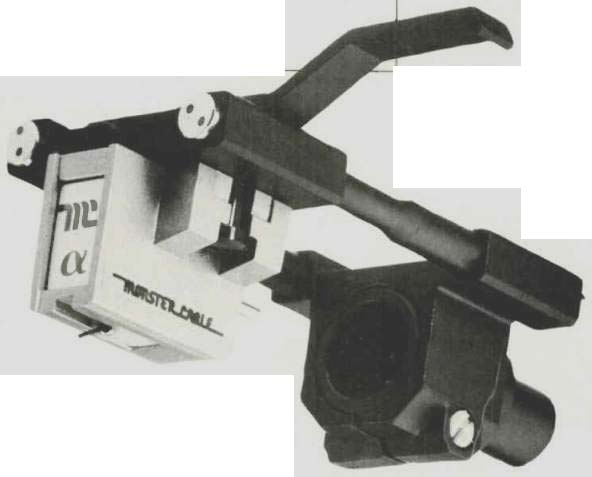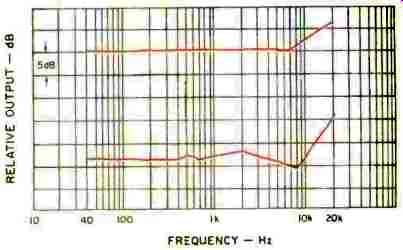
Manufacturer's Specifications:
Frequency Response: 10 Hz to 50 kHz; 20 Hz to 20 kHz, ± 1 dB.
Vertical Tracking Force: 1.75 grams (17.5 mN).
Channel Separation: Greater than 25 dB at 1 kHz.
Channel Balance: 0.2 dB.
Stylus Rake Angle: 0°, ± 2.0°, with proper VTA set at 19° to 20°.
Stylus: Line-contact, nude diamond, 0.1-mm square shank.
Tip Dimensions: 6 x 35 microns.
Cantilever: Hollow amorphous boron tube, 0.4 mm diameter x 6 mm long; inner diameter, 0.3 mm.
Compliance: 15 x 10^-6 cm/dyne at 11 Hz, 70° F.
Output: 0.3 mV at 5 cm/S at 1 kHz.
Internal Impedance: 4 ohms.
Recommended Load Impedance: 40 to 100 ohms; optimum, 80 ohms.
Weight: 6.5 grams.
Price: $475.00.
Company Address: 101 Townsend St., San Francisco, Cal. 94107.
Despite the spectre of the laser-beam phono pickup looming over the analog phono cartridge, new models continue to be designed, developed, and introduced in the audio marketplace. A recent entry, the Alpha-1 moving-coil phono cartridge, comes from Monster Cable, known primarily tor their high-quality cable and connector accessories.
The Alpha-1 utilizes an ultra-rigid, hollow-tube cantilever made from boron, which is extremely hard and light. To reduce the cantilever resonance as well as equivalent moving mass, this cartridge incorporates a paralleled dual damper system on the rigid boron cantilever. The stylus is made from a 0.1-mm square-shank diamond, with a special line-contact configuration, that has been brought to a fine mirror polish and nude-mounted on the boron cantilever.
Magnetic circuits, including those in moving-coil phono cartridges, develop Foucault (eddy) currents on their surfaces. The unique new "magnetic feedback control" circuit in the Alpha-1 eliminates these unwanted currents, which are said to blur transients and cause both phase and inter modulation distortion.
The Alpha-1 comes mounted in a sturdy, round, machined aluminum canister located within the two halves of a styrofoam box that also contains a small screwdriver, screws, nuts, a small packet of Stylast stylus-treatment fluid by LAST, and a small, dense stylus-cleaning brush. The styrofoam container is enclosed in a nice-looking display box.
Measurements

Fig. 1--Frequency response (upper curve) and separation.
Due to the minute size of the moving coils, the signal output is very low and a step-up device is needed to raise the output voltage to a level that can be used with the usual preamplifier phono input stage. Accordingly, most of the reported measurements of the Monster Cable Alpha-1 were made using my measuring amplifier and, where necessary, the Audio Interface CST-80H, a 40-ohm, step-up transformer. All musical evaluation was done with this transformer (see my review of it in Audio, December 1982), which proved to be an excellent, passive-matching device for the Alpha-1.
The Alpha-1 was mounted in a Technics headshell and used with the Technics EPA-A250 (S-shaped) interchangeable tonearm unit attached to the Technics EPA-500 tone arm base mounted on a Technics SP-10 Mk II turntable. The Alpha-1 was oriented in the headshell and tonearm with the Dennesen Geometric Soundtracktor.
Laboratory tests were conducted at an ambient temperature of 72° F (22.22° C) and a relative humidity of 66%, ±3%. The tracking force for all reported tests was set at 1.75 grams, with an anti-skating force of 2.1 grams. The load resistance at the phono input was 47 kilohms, and the load capacitance was 300 pF. As is my practice, measurements were made on both channels, but only the left channel is reported unless there is a significant difference between the two channels, in which case both channels are reported for a given measurement.
The following test records were used in making the reported measurements: Columbia STR-100 and STR-112; Shure TTR-103, TTR-109, TTR-110, TTR-115, and TTR-117; Deutsches HiFi No. 2; Nippon Columbia Audio Technical Record (PCM) XL-7004; B & K OR-2010, and Ortofon 0002.
Frequency response, using the Columbia STR-100 test record (Fig. 1), was 0.5, + 6.25 dB from 40 Hz to 20 kHz.
Response is ±0 dB from 40 Hz to 5 kHz, ±0.5 dB to 8 kHz, and from ±0.5 to +6.25 dB between 8 kHz to 20 kHz.
Separation was 22.5 dB at 1 kHz, 27 dB at 8 kHz, 24.5 dB at 10 kHz, 19.5 dB at 15 kHz, and 16 dB at 20 kHz. The data indicate that the Alpha-1 has an excellent frequency response and a very good high-frequency separation. The rise in the frequency response from about 8 to 20 kHz is typical of most moving-coil phono cartridges. The 1-kHz square-wave response (Fig. 2), using the Columbia STR112 test record, is consistent with that seen for most moving-coil phono cartridges, where there is a large overshoot (equal in amplitude to that of the square-wave itself), followed by a low-level ringing that decays rapidly. This ringing is probably due to a relatively undamped stylus resonance that takes place at about 35 kHz, in addition to some ultrasonic cutter ringing present on the test record. To measure the arm-cartridge low-frequency resonance, it was necessary to disable the arm's anti-resonance unit. The arm-cartridge low-frequency lateral resonance point for the left channel was 7 Hz with a 4-dB rise, while for the right channel it was also 7 Hz but with a 5-dB rise. Vertical resonance was at 8 Hz. Neither the lateral nor the vertical low-frequency resonance was measurable when this tone arm's anti-resonance device was used.
Using the Dynamic Sound Devices DMA-1 Dynamic Mass Analyzer, the arm-cartridge dynamic mass was measured as 20 grams, and the dynamic vertical compliance as 20 x 10-6 cm/dyne at the vertical resonant frequency of 8 Hz. The harmonic distortion components of the 1-kHz, 3.54 cm/S rms 45° velocity signal from the Columbia STR-100 test record are: 1.78% second harmonic and 0.5% third harmonic, with less than 0.25% higher order terms. The vertical stylus angle measured 25.5° using the CBS Model 3002 Vertical Tracking Angle Meter.
Other measured data are: Wt., 6.5 g. Opt. tracking force, 1.75 g. Opt. anti-skating force, 2.1 g. Output, 0.12 mV/cm/S. IM distortion (200/4000 Hz, 4-to-1): Lateral (+9 dB), 0.72%; vertical (+6 dB), 3.4%. Crosstalk (using Shure TTR-109): Left,-17 dB; right, 22 dB. Channel balance, 0.5 dB. Trackability: High-freq. (10.8-kHz, pulsed), 30 cm/S; mid-freq. (1000 and 1500 Hz, lat. cut), 31.5 cm/S; low-freq. (400 and 4000 Hz, lat. cut), 24 cm/S; Deutsches-HiFi No. 2, 300 Hz test band was tracked cleanly to 86 microns (0.0086 cm) lateral at 16.20 cm/S at +9.66 dB and to 55.4 microns (0.00554 cm) vertical at 10.32 cm/S at +5.86 dB.

Fig. 2--Response to a 1-kHz square wave.
The Alpha-1 cleanly played all the test bands on both the Shure Obstacle Course Era Ill and Era IV musical test records, and all six levels of the Shure Obstacle Course Era V test record also were tracked without mishap. This is a remarkable feat inasmuch as it is a rare cartridge, indeed, that is able to track all the peak recorded velocities on these records, some of which exceed 50 cm/S (the peak recorded velocities of commercial analog records averages about 15 cm/S). Of course, as was expected, the Alpha-1 was able to track, without difficulty, all the high-velocity cannon fire present on the Tchaikovsky 1812 (Telarc DG-10041) in a truly awesome manner.
Use and Listening Tests
As usual, I performed many hours of listening tests, both before and after measurement. Equipment used in the listening evaluation of the Alpha-1 included the aforementioned Technics arm and turntable, the Audio-Technica AT666EX vacuum disc stabilizer, a Crown IC-150 preamplifier, two VSP Labs Trans-MOS 150 amplifiers, each used in the 300-watt mono mode, and a pair of Pentagram P-10 full range loudspeakers connected to the two VSP amplifiers with 4PR Kimber Kable in parallel with the Live Wire speaker cable, as recommended by the speaker manufacturer.
Some of the other exceptionally good records I used to audition the Alpha-1 were Wheels & Pipes (Warren Lubich, organist, Sonic Arts LS-28), Elgar's Falstaff: Symphonic Study (London Philharmonic, Boult, Mobile Fidelity MFSL 2501), Listen (L.A. Jazz Choir, Mobile Fidelity MFSL 1-096), and Frederick Fennell, The Cleveland Symphonic Winds (Telarc DG-10050). The Alpha-1 moving-coil phono cartridge was able to accurately and cleanly reproduce Fritz Reiner and the Chicago Symphony Orchestra's superb, re-mastered, and now near-legendary Strauss: Also Sprach Zarathustra (RCA Red Seal Point Five Series ATL1-4286). Transient response, tracking ability, and transparency of sound were excellent.
While listening to various recordings, I noted that the Alpha 1 had unquestionably good sonic clarity and stereo imaging with no detectable coloration, especially when reproducing the high recorded velocities present on most audiophile recordings. Bass was sonically well defined and tight. Although there is a gradual rise in frequency at the high end, which is typical for moving-coil cartridges, I did not feel that the Alpha-1 produced overly bright sound.
All in all, I am impressed with the Alpha-1, especially with its ability to flawlessly reproduce any recorded sound. The Alpha-1 moving-coil phono cartridge by Monster Cable is truly deserving of serious consideration by audiophiles as well as all music lovers.
-B. V. Pisha
(Source: Audio magazine, Jan. 1984)
Also see: Monster Cable Alpha 2 Cartridge (Apr. 1987)
Megasonics MC-10 strain-gauge phono cartridge (Apr. 1982)
= = = =